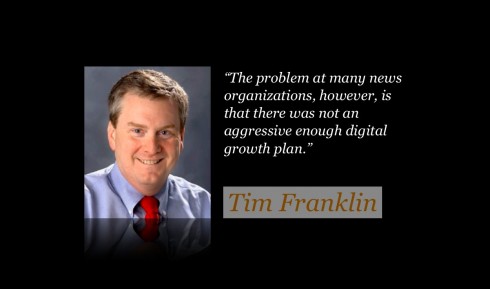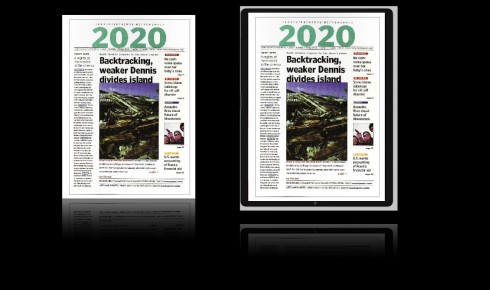TAKEAWAY: Bloomberg News’ Timothy Franklin answers our one question about American editors and publishers. PLUS: In Vienna, a Publishing for the 2020’s conference attracts many questions about the future of media.

What a great satisfaction is to read an article, or a book, and find out that you agree 100% with the author. Moments like that do not come often, of course. But it happened to me as I read a piece written by Timothy Franklin published in the Nieman Reports.
No sooner had I finished reading Tim’s article that I contacted him for additional information for today’s blog. He graciously wrote back very quickly and I share his views with you.
First, about the article: Tim, who is a managing editor in the Washington bureau of Bloomberg News, was the editor of The Baltimore Sun from January 2004 to December 2008. Between those jobs, he was an endowed chair in the Indiana University School of Journalism and started up its National Sports Journalism Center. This has given Tim
some formidable platforms in which to think about the state of the media. More importantly, he has reflected on what he would do at the Baltimore Sun if he was arriving as editor again.
Take a look at these bullet points from Tim:
Why print everyday? Instead of printing the paper every day, ‘we would provide to our subscribers an e-reader such as a Kindle or a Nook. This serves the dual purpose of strengthening our print editions on key days and building an e-reading habit …’
“No prisoner to pulp”: my new mantra for the newsroom would be: We are a digital news operation with a print component. We are not a print newsroom with a digital component. That is the organizing principle that guides all of our decisions, I would tell my staff.
Make them pay: My newsroom would aspire to be a service-oriented, one-stop news and information portal for the region. For a modest subscription fee, my newsroom would give readers different tiers of information based on the device they’re using and their needs. Yes, frequent users would pay.
Beef up Sundays: Our franchise Sunday newspaper will be meatier and a showcase for powerful local storytelling. We can afford it because we’re cutting our print losses three other days of the week and using our resources differently.
The cult of personality: Personalities can be brands, too. My newsroom would celebrate our personalities and create more of them. They provide a personal connection with readers and unique voices for the community.
Covering those invisible stories: Perhaps the single biggest mistake editors and publishers have made in recent years is cutting the number of investigative reporters. Any new newsroom paradigm also must have a back-to-the-basics approach, with a commitment to accountability journalism.
After I read Tim’s report, and just coming out of a day of conversation in Vienna with participants and speakers at the VOZ Publishing 2020 conference (see below), and mentioning so many of these same points, Tim’s piece was total validation. I sent him one question that is present at all these gatherings:
One question for Timothy Franklin
Mario: Tim, this is a question I get from clients and conference attendees abroad all the time:
Why do you think so many American newspaper editors and publishers missed the boat in such grand style during the 90s and the first decade of this century?
Tim:
There’s a two-part answer to your question.
In the mid 1990s, my view is that publishers and editors largely viewed the
Internet as being complimentary to print. It was perceived as a new vessel for
news and information, and a new revenue stream. But, it wasn’t widely thought to be a replacement for print—at least not in the near future.In the next decade, it became obvious that digital was a real threat to the
readership and revenue of print editions. Fueled by both the secular change in
the industry and a couple of brutal recessions, newspaper revenue plummeted.Publishers then had to rescale the business to match falling ad revenue, which
was understandable. The problem at many news organizations, however, is that
there was not an aggressive enough digital growth plan. There should have been
two parallel tracks: Reorganizing the print editions, and heavily investing in
a robust digital strategy for the future. Too many places did the former and
not the latter.There are some real innovations taking place now on the digital side at these
legacy news organizations, and my sincere hope is that they’re taking hold.
Meanwhile, at the VOZ Publishing for the 2020s conference

Tim’s reflections are totally related to my experience with the editors and publishers gathered for the VOZ Publishing in 2020 conference in Vienna.
I spent a good part of my day yesterday at the conference in Vienna, addressing and mingling with a group of Austrian editors and publishers. There were many good exchanges, and the same type of questions and concerns that are now standard in these gatherings. Perhaps the Timothy Franklin heavy dose of medicine would have been a bit strong, but maybe not.
These are the most often asked questions:
-How do you see the future of print?
There is a future for print, but survival is for those who adapt, and see the role of print changing dramatically, becoming a part of a media quartet.
-Should we move our efforts toward Digital First?
The story comes first, then the platforms (are you tired of me saying this?)
-Is the tablet the game changer it is supposed to be?
Indeed, it is, but the mobile telephone must not be ignored.
-And, if the print product is still the cash cow, how can we do it justice while at the same time investing and concentrating on a digital future?
There is no choice here: digital is the future in a world where mobiles, online, print and tablets will coexist, with users selecting the platform or platforms they wish to engage with, and, in many cases, engaging in several throughout the course of a day.
Obviously, not very easy questions to answer. However, speaker after speaker, presented case studies of their publications. Speakers from Germany, Switzerland and Austria showed all their progress with mobile telephone and tablet edition development, while presenting numbers.
When the speaker from Switzerland, Peter Wälty, chief editor for Newsnet, showed Tages Anzeiger and its very nice tablet edition, one that we have often referred to here, the gentleman sitting next to me responded: but it is still not making any money.
“You must give it time,” I reminded him.Tages Anzeiger’s team are on the right track, diversifying, extending their brand and producing what I think is one of the best newspaper apps in terms of presentation and usability.
The conversation turned to economics several times during the day, including lunch,when a group of publishers around me kept saying that they were afraid to concentrate too much on the digital at the expense of print which continues to be the revenue producing medium.
“Our situation in Austria is very different from that of the United States or even larger countries in Europe,” Josef Trappel, a media economist from the University of Salzburg, told me.
The feeling was echoed by other editors around the table.
My so called “creative keynote” did not put much emphasis on the economics of the tablet, but on the platform itself. One message that I wanted to make clear, and which was much appreciated by the audience: Editors in every newsroom must show an open mind, a genuine disposition to change.
As I looked at the audience of about 120, I saw smiles on their faces, or colleagues looking at each other.
The same type of smile that I had reading the Timothy Franklin piece. I would make his article required reading in every newsroom.
2020 all over again?

My version of what a newspaper front page might be like in 2020 (as created for American Press Institute seminar in 1999)
There seems to be a fascination among conference organizers with the year 2020. Indeed, in 1999, at the American Press Institute, a group of designers were called to create what we thought would be the ideal newspaper for that year 2020 (which is now almost upon us). It was a fun discussion, with 36 of us arriving at the API headquarters in Reston, Virginia, with a model of what we thought would be like. Roger Fidler arrived “tablet” in hand, visionary that he is.
Here is my version, which although aimed at a printed publication (I still think there are printed newspapers in 2020, by the way), it was compact, in an A4 format, and, yesterday in Vienna, as I put final touches on my presentation, I pulled my 2020 newspaper front page from the depth of the old files, and decided it to show it. It fits into the iPad screen, by the way. Still believe in that front page today as much as I did in 1999.
See more of my 2020 page concept here:
https://garciamedia.com/blog/articles/the_newspaper_of_2020_and_beyond_see_pure_design_download
Newspapers in 2020: Paper vs. Digital Delivery and Display Media
http://dictum4magz.wordpress.com/2007/12/10/newspapers-in-2020-paper-vs-digital-delivery-and-display-media/
Students design newspaper of the future
https://garciamedia.com/blog/articles/students_design_newspaper_of_the_future_yes_it_is_printed
Of related interest:
Tages Anzeiger’s new iPad app: it offers interesting extras
https://garciamedia.com/blog/articles/tage
For our German language readers, these were reports of my keynote in the Austrian press:
Medien am Tablet: Der Finger darf nicht faul sein
http://diepresse.com/home/kultur/medien/743760/Medien-am-Tablet_Der-Finger-darf-nicht-faul-sein
Zeitungsdesigner Mario Garcia: “Man muss Geld investieren, um Geld zu verdienen”
http://derstandard.at/1331780062478/Tablet-Werbung-Zeitungsdesigner-Mario-Garcia-Man-muss-Geld-investieren-um-Geld-zu-verdienen
Zeitung zum Lesen und Anfassen:
Zukunft. Designer Mario Garcia über die keineswegs tote Zeitung und faule Finger.
http://search.salzburg.com/news/artikel.html?uri=http%3A%2F%2Fsearch.salzburg.com%2Fnews%2Fresource%2Fsn%2Fnews%2Fsn2718_27.03.2012_41-38793217
Also of interest today:
Why Android Tablet Apps Suck and the iPad Wins: An Illustrated Guide
http://www.pcmag.com/slideshow_viewer/0,3253,l%253D295472%2526a%253D295476%2526po%253D1,00.asp?p=n
Apple says new iPad battery designed to discharge automatically when full – Silicon Valley / San Jose Business Journal
http://www.bizjournals.com/sanjose/news/2012/03/27/apple-says-new-ipad-battery-charges-as.html?ana=e_du_pub&s=article_du&ed=2012-03-27